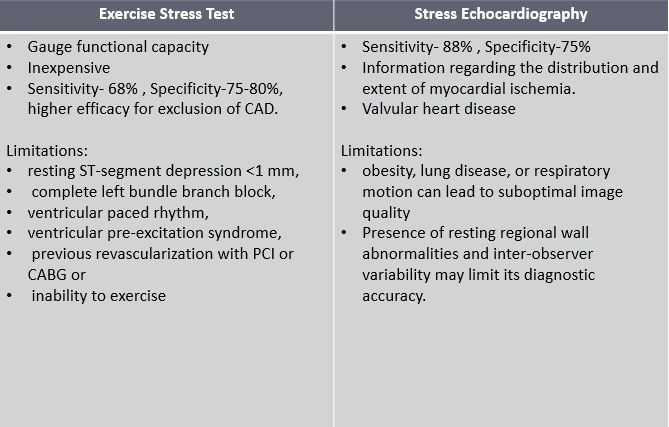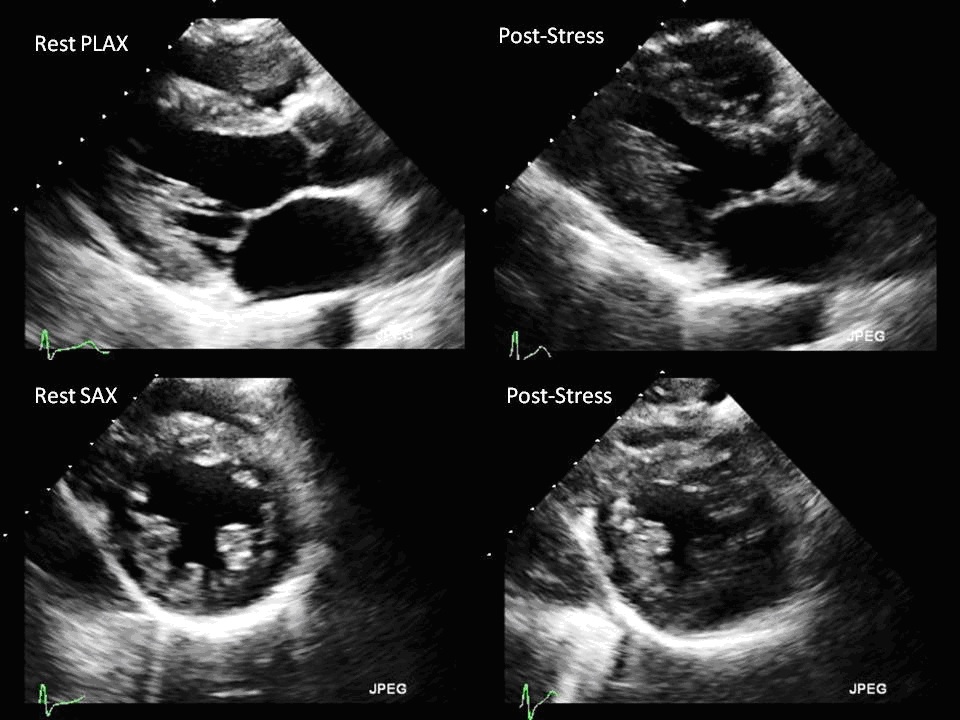[1]
Picano E, Pasanisi E, Venneri L, Agrusta M, Mottola G, Sicari R. Stress echocardiography. Current pharmaceutical design. 2005:11(17):2137-49
[PubMed PMID: 16026284]
[2]
Gillam LD, Marcoff L. Stress Echocardiography. Circulation. Cardiovascular imaging. 2019 Jun:12(6):e009319. doi: 10.1161/CIRCIMAGING.119.009319. Epub 2019 Jun 17
[PubMed PMID: 31203671]
[3]
Sicari R, Cortigiani L. The clinical use of stress echocardiography in ischemic heart disease. Cardiovascular ultrasound. 2017 Mar 21:15(1):7. doi: 10.1186/s12947-017-0099-2. Epub 2017 Mar 21
[PubMed PMID: 28327159]
[4]
Pellikka PA, Nagueh SF, Elhendy AA, Kuehl CA, Sawada SG, American Society of Echocardiography. American Society of Echocardiography recommendations for performance, interpretation, and application of stress echocardiography. Journal of the American Society of Echocardiography : official publication of the American Society of Echocardiography. 2007 Sep:20(9):1021-41
[PubMed PMID: 17765820]
[5]
Ágoston G, Morvai-Illés B, Pálinkás A, Varga A. The role of stress echocardiography in cardiovascular disorders. Kardiologia polska. 2019 Nov 22:77(11):1011-1019. doi: 10.33963/KP.15032. Epub 2019 Oct 24
[PubMed PMID: 31647477]
[6]
Pellikka PA, Roger VL, Oh JK, Miller FA, Seward JB, Tajik AJ. Stress echocardiography. Part II. Dobutamine stress echocardiography: techniques, implementation, clinical applications, and correlations. Mayo Clinic proceedings. 1995 Jan:70(1):16-27
[PubMed PMID: 7808046]
[7]
Aggeli C, Polytarchou K, Varvarousis D, Kastellanos S, Tousoulis D. Stress ECHO beyond coronary artery disease. Is it the holy grail of cardiovascular imaging? Clinical cardiology. 2018 Dec:41(12):1600-1610. doi: 10.1002/clc.23094. Epub 2018 Nov 24
[PubMed PMID: 30315566]
[8]
Kossaify A, Bassil E, Kossaify M. Stress Echocardiography: Concept and Criteria, Structure and Steps, Obstacles and Outcomes, Focused Update and Review. Cardiology research. 2020 Apr:11(2):89-96. doi: 10.14740/cr851. Epub 2020 Mar 10
[PubMed PMID: 32256915]
[9]
Płońska-Gościniak E, Gackowski A, Kukulski T, Kasprzak JD, Szyszka A, Braksator W, Gąsior Z, Lichodziejewska B, Pysz P. Stress echocardiography. Part I: Stress echocardiography in coronary heart disease. Journal of ultrasonography. 2019:19(76):45-48. doi: 10.15557/JoU.2019.0006. Epub
[PubMed PMID: 31088010]
[10]
Mulvagh SL, Rakowski H, Vannan MA, Abdelmoneim SS, Becher H, Bierig SM, Burns PN, Castello R, Coon PD, Hagen ME, Jollis JG, Kimball TR, Kitzman DW, Kronzon I, Labovitz AJ, Lang RM, Mathew J, Moir WS, Nagueh SF, Pearlman AS, Perez JE, Porter TR, Rosenbloom J, Strachan GM, Thanigaraj S, Wei K, Woo A, Yu EH, Zoghbi WA, American Society of Echocardiography. American Society of Echocardiography Consensus Statement on the Clinical Applications of Ultrasonic Contrast Agents in Echocardiography. Journal of the American Society of Echocardiography : official publication of the American Society of Echocardiography. 2008 Nov:21(11):1179-201; quiz 1281. doi: 10.1016/j.echo.2008.09.009. Epub
[PubMed PMID: 18992671]
Level 3 (low-level) evidence
[11]
Ntoskas T, Ahmad F, Woodmansey P. Safety and efficacy of physiologist-led dobutamine stress echocardiography: experience from a tertiary cardiac centre. Echo research and practice. 2018 Sep 1:5(3):105-112. doi: 10.1530/ERP-18-0038. Epub 2018 Sep 1
[PubMed PMID: 30303679]
[12]
Badiani S, Waddingham P, Lloyd G, Bhattacharyya S. Stress echocardiography in valvular heart disease. Expert review of cardiovascular therapy. 2018 Nov:16(11):795-804. doi: 10.1080/14779072.2018.1532791. Epub 2018 Oct 10
[PubMed PMID: 30286667]
[13]
Picano E, Ciampi Q, Wierzbowska-Drabik K, Urluescu ML, Morrone D, Carpeggiani C. The new clinical standard of integrated quadruple stress echocardiography with ABCD protocol. Cardiovascular ultrasound. 2018 Oct 2:16(1):22. doi: 10.1186/s12947-018-0141-z. Epub 2018 Oct 2
[PubMed PMID: 30285774]
[14]
Berbarie RF, Dib E, Ahmad M. Stress echocardiography using real-time three-dimensional imaging. Echocardiography (Mount Kisco, N.Y.). 2018 Aug:35(8):1196-1203. doi: 10.1111/echo.14050. Epub 2018 Jun 20
[PubMed PMID: 30133883]
[15]
Picano E, Sicari R, Varga A. Dipyridamole stress echocardiography. Cardiology clinics. 1999 Aug:17(3):481-99, viii
[PubMed PMID: 10453294]
[16]
Imran MB, Pálinkás A, Picano E. Head-to-head comparison of dipyridamole echocardiography and stress perfusion scintigraphy for the detection of coronary artery disease: a meta-analysis. Comparison between stress echo and scintigraphy. The international journal of cardiovascular imaging. 2003 Feb:19(1):23-8
[PubMed PMID: 12602478]
Level 1 (high-level) evidence
[17]
Bigi R. Complications of pharmacologic stress echocardiography in coronary artery disease. Clinical cardiology. 1996 Oct:19(10):776-80
[PubMed PMID: 8896909]
[18]
Mansencal N, Mustafic H, Hauguel-Moreau M, Lannou S, Szymanski C, Dubourg O. Occurrence of Atrial Fibrillation During Dobutamine Stress Echocardiography. The American journal of cardiology. 2019 Apr 15:123(8):1277-1282. doi: 10.1016/j.amjcard.2019.01.022. Epub 2019 Jan 31
[PubMed PMID: 30745020]
[19]
Pinton R, Lemke W, Garcia LG. [Symptoms, complications and hemodynamic changes related to dobutamine stress echocardiography]. Arquivos brasileiros de cardiologia. 1997 Sep:69(3):161-4
[PubMed PMID: 9595726]
[20]
Geleijnse ML, Krenning BJ, Nemes A, van Dalen BM, Soliman OI, Ten Cate FJ, Schinkel AF, Boersma E, Simoons ML. Incidence, pathophysiology, and treatment of complications during dobutamine-atropine stress echocardiography. Circulation. 2010 Apr 20:121(15):1756-67. doi: 10.1161/CIRCULATIONAHA.109.859264. Epub
[PubMed PMID: 20404267]
[21]
Hirano Y, Yamamoto T, Uehara H, Nakamura H, Wufuer M, Yamada S, Ikawa H, Ishikawa K. [Complications of stress echocardiography]. Journal of cardiology. 2001 Aug:38(2):73-80
[PubMed PMID: 11525112]
[22]
Picano E, Alaimo A, Chubuchny V, Plonska E, Baldo V, Baldini U, Pauletti M, Perticucci R, Fonseca L, Villarraga HR, Emanuelli C, Miracapillo G, Hoffmann E, De Nes M. Noninvasive pacemaker stress echocardiography for diagnosis of coronary artery disease: a multicenter study. Journal of the American College of Cardiology. 2002 Oct 2:40(7):1305-10
[PubMed PMID: 12383579]
Level 2 (mid-level) evidence


